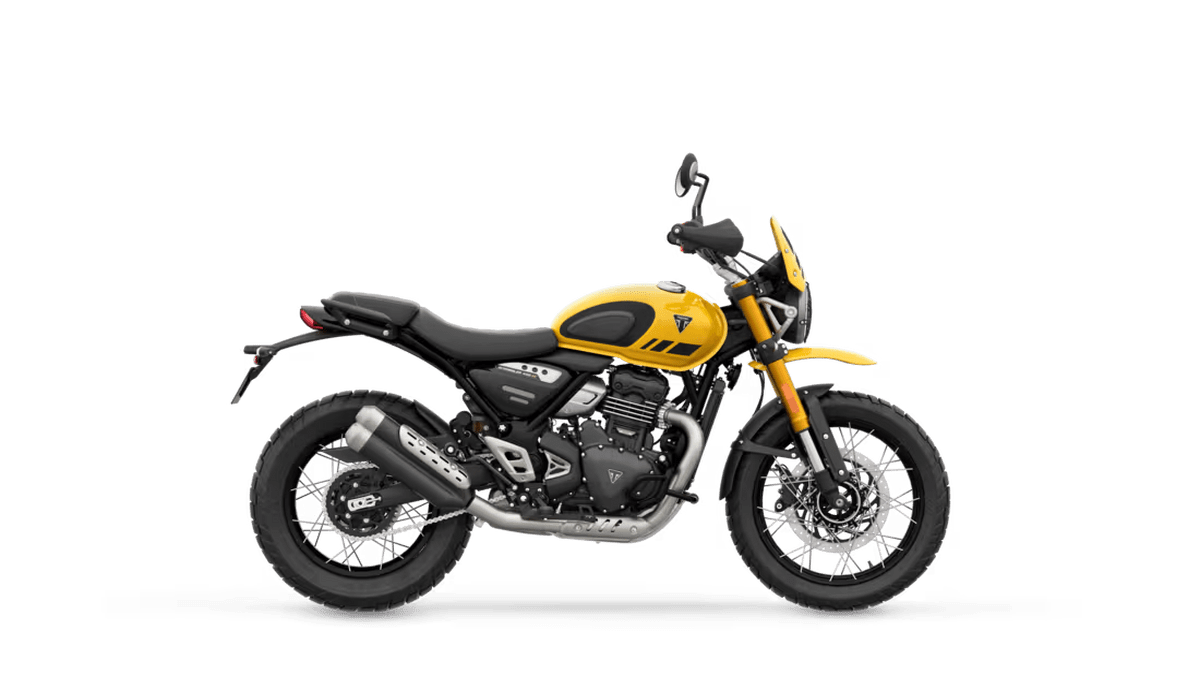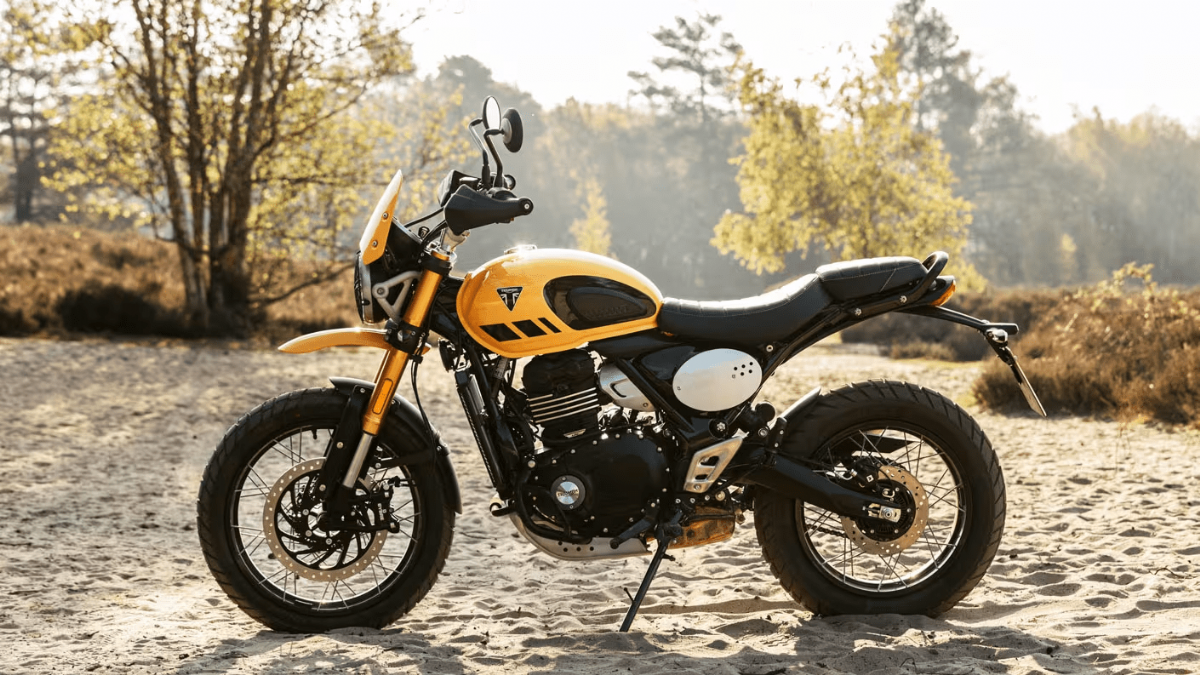SCRAMBLER 400 XC

Experience rugged Triumph Scrambler attitude and ability.
The new Scrambler 400 XC is built strong, from its beautifully-crafted spoked wheels and tubeless tyres to tough protection features and purposeful high-level front mudguard. Embrace the thrill and discover the freedom to venture off the beaten track.

Rugged Scrambler Attitude
An assertive silhouette, commanding presence and iconic Triumph Scrambler design DNA. From the wheels up, the Scrambler 400 XC is as purposeful as it is unmistakable. The upright riding position and wide bars combine with a seat height of 835mm for superior visibility, confidence and control.

CMS Item : ADVENTURE-READY TUBELESS SPOKED WHEELS
The stainless-steel spoked wheels with lightweight aluminium rims and larger 19-inch front are side-laced - so not only are they ready for off-road exploration, they're beautifully crafted too. Premium branded tubeless tyres provide confidence, wherever the path leads.

BUILT TOUGH
Protection for both bike and rider. A rugged high-level front mudguard, colour-coded flyscreen and hand guards shield the rider in tough conditions, while an aluminium sump guard, engine bars and headlight grille safeguard the bike's vital components.

Modern Rider Technology
The Scrambler 400 XC is equipped with the latest rider-focused technology to enhance every ride. Switchable Traction Control and a dedicated Off-road ABS mode provide complete confidence and control when conditions get tough, while a convenient USB-C port ensures power to your mobile devices on longer adventures.

PERFORMANCE WITH PERSONALITY
With strong low-end torque and flexible performance that adapts to any riding scenario, the TR-Series engine's characterful power delivery is rich and rewarding, with a deep and distinctive soundtrack. Its classic looks are enhanced by the latest riding technology, seamlessly integrated to deliver timeless style with modern capability.

AGILE AND ASSURED
The dedicated Scrambler chassis features a longer wheelbase for stability and comes equipped with high specification components, from 43mm Big-Piston upside down front forks and the piggy-back RSU with preload adjustment to a powerful and progressive 4-piston radial caliper and large 320mm front brake disc.

A FLAWLESS FINISH
The Scrambler 400 XC stands-out with a high specification and top draw finish. Meticulously crafted with unparalleled attention to detail; from the black powder coated engine casing and machined cooling fins, to the cast aluminium swingarm and gold anodized forks, the devil really is in the details.

TIMELESS DNA
Style with substance; the Scrambler's design incorporates hallmark Triumph features, from the signature sculpted fuel tank with knee indents, rubber knee pads and classic engine profile with Triumph triangle badge, to the finned head and header clamps and flowing upswept silencer.
From off-road sport to the road
1978 to 1980:
In 1978, BMW Motorrad attracted attention with a predecessor to the first GS: The GS 80 takes in two gold medals at the International Six Days Enduro. The bike had been developed by an in-house team of developers without an official remit. But its success proved the engineers and mechanics right: their bike made it truly enjoyable to ride both off-road and on-road. It was released to the market in 1980 under a slightly different name, the BMW R 80 G/S.
Its rise begins
1980 to 1987:
With the GS, BMW Motorrad created the perfect synthesis of off-road and on-road driving: Regardless of surface type, riders have control over their bikes in every situation while also enjoying maximum comfort on long routes. The highlight is the monolever single-sided swinging arm, which is the first to be installed on a motorcycle worldwide. This reduces the weight and enables the rear wheel to be changed quickly. With the R 80 G/S, BMW Motorrad created the segment for large, comfortable travel enduros – a segment that it still dominates today.
The GS gains momentum: more displacement, more power
1987 to 1996:
The new top model, the R 100 GS, focuses on a lot of displacement: it is the most powerful and fastest enduro on the market. The paralever dual-pivot swinging arm on the rear wheel ensures effortless handling off-road and on-road. With its striking black and yellow paintwork, it is known as “Bumblebee”. The colour is still hugely popular among fans today and decorates this year's special “40 Years GS Edition" model.
A new chapter in travel enduros
1994 to 2003:
The GS is on its way to becoming an icon while continuously changing: in 1994, the first enduro with a four-valve boxer engine appears with the R 1100 GS. The bike is popular because it handles well off road and performs perfectly on long tours. In 1999, the R 1150 GS follows in its footsteps. The concept is purposefully further developed with touring in mind and, in 2002, adapted even more to the needs of long-distance travellers with the R 1150 GS Adventure – the Adventure series is born.
From one-cylinder to two-cylinder
2000 to 2008:
The very popular and novice-friendly “Funduro” models, the F 650 and F 650 ST, have their engines reworked at the beginning of the new millennium. Thanks to the water-cooled single-cylinder assembly, F 650 GS and F 650 GS Dakar riders have enough drive for everyday riding as well as that typical enduro feeling. In 2008, the F 650 GS and F 800 GS, both completely redesigned enduro models, are equipped with a liquid-cooled two-cylinder in-line engine. The means pure adventure, even in the mid-range segment.
From air-cooled to water-cooled boxer engine
2004 to 2017:
In 2004, BMW Motorrad re-released the R 1200 GS. The bike is given more displacement, power, and torque, making it even more dynamic on any terrain while weighing 30 kilograms less at the same time. A new era begins almost ten years later, when BMW Motorrad engineers equip the R 1200 GS with a water-cooled boxer engine – something that had never been done before. The bike also has a semi-active suspension with Dynamic ESA (electronic suspension adjustment), which takes handling and riding comfort to a new level.
The GS becomes even stronger
In the following years, BMW Motorrad continued to build on the GS legend. The popular R 1250 GS appears with a redeveloped two-cylinder boxer engine. Thanks to its variable BMW ShiftCam camshaft control, it provides more power in all speed ranges and makes the GS even more effortless. In addition, the mid-range F 750 GS and F 850 GS models undergo constant development and make riding more enjoyable with their larger displacement and modified chassis.
| ENGINE & TRANSMISSION | |
|---|---|
| Type | Liquid-cooled, single-cylinder, 4 valve, DOHC |
| Capacity | 398 cc |
| Bore | 89.0 mm |
| Stroke | 64.0 mm |
| Compression | 12.0:1 |
| Max Power EC | 40 PS / 39.5 bhp (29.4 kW) @ 8,000 rpm |
| Max Torque EC | 37.5 Nm @ 6,500 rpm |
| System | Bosch electronic fuel injection with electronic throttle control |
| Exhaust | Stainless twin-skin header system with stainless steel silencer |
| Final Drive | X-ring chain |
| Clutch | Wet, multi-plate, slip |
| Gearbox | 6-speed |
| CHASSIS | |
|---|---|
| Frame | Hybrid spine/perimeter, tubular steel, bolt-on rear subframe |
| Swingarm | Twin-sided, cast aluminium alloy |
| Front Wheel | Spoked Tubeless, 19 x 2.5 in |
| Rear Wheel | Spoked Tubeless, 17 x 3.5 in |
| Front Tyre | 110/90-19 |
| Rear Tyre | 140/80-17 |
| Front Suspension | 43mm upside down Big Piston forks. 150mm wheel travel |
| Rear Suspension | Gas monoshock RSU with external reservoir and pre-load adjustment. 150mm wheel travel |
| Front Brakes | Single 320mm fixed disc, four-piston radial caliper, ABS |
| Rear Brakes | Single 230mm fixed disc, single piston floating caliper, ABS |
| Instrument Display and Functions | Analogue speedometer with integrated multi-function LCD screen |
| DIMENSIONS & WEIGHTS | |
|---|---|
| Height Without Mirror | 1169 mm |
| Seat Height | 835 mm |
| Wheelbase | 1418 mm |
| Rake | 23.2 ° |
| Trail | 108 mm |
| Tank Capacity | 13 L |
| Wet Weight | 186 kg |
| FUEL CONSUMPTION | |
|---|---|
| Fuel Consumption | 3.8 litres / 100 km |
| SERVICE | |
|---|---|
| Service Interval | 10,000 miles (16,000km)/12 months (whichever comes first) |
